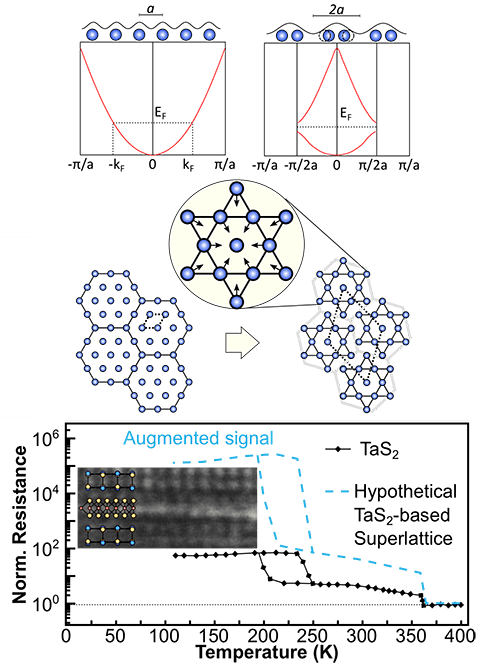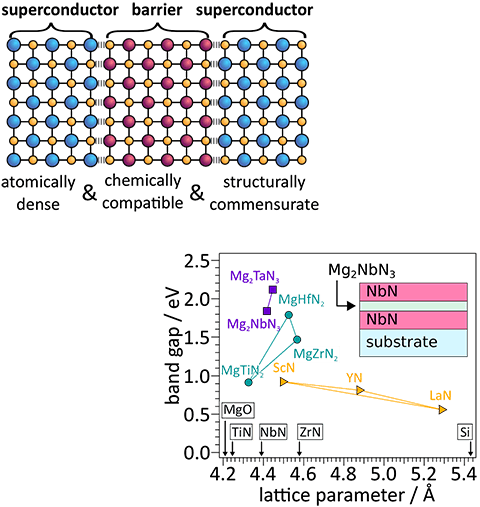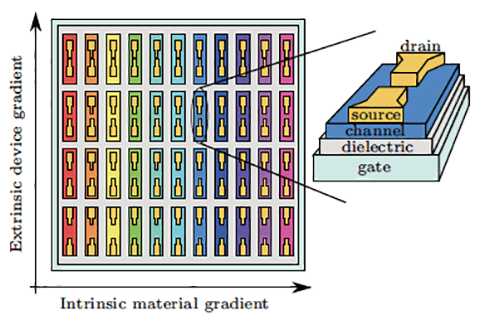Electronic Materials Research
NREL's electronic materials research focuses on neuromorphic computing, quantum computing, and thin-film transistors (TFTs) as well as traditional microelectronics.
Materials for Neuromorphic Computing
Processing and storing information already constitute a significant fraction of the global energy demand, which will soon become unsustainable. Neuromorphic computing holds a promise to address this problem by operating similarly to the human brain, which is over 1 million times more energy efficient than modern computers. Unfortunately, efficiently recreating the complex dynamics of neurons and synapses with inorganic materials is quite difficult. Biological signals can be mimicked by quantum-phase transitions, which carry an inherently low energy burden. For more information, see the following publications:
Synthesis of Tunable SnS-TaS2 Nanoscale Superlattices, Nano Letters (2020)
Metal Chalcogenides for Neuromorphic Computing: Emerging Materials and Mechanisms, Nanotechnology (2021).
Charge Density Waves

One example, charge density waves (CDWs), arise from electron-phonon interactions and have been utilized to mimic both synaptic and neuronal functionalities. However, simultaneously achieving both useful operation temperatures and large signal is difficult. We seek to use quasi 2-dimensional superlattice materials to tune quantum-phase transitions because they are known to increase both the transition temperature and amplitude of CDW signals.
A promising material for this is tantalum disulfide due to its 2D nature and rich CDW behavior. Starting from scratch, we built a new synthesis platform for sulfide superlattices, which are now being evaluated for simulation of neuronal dynamics.
Insulator-Metal Transition
Another mechanism leveraged for neuromorphic computing is the insulator-metal transition (IMT), a temperature dependent structural or electronic phase change resulting in a large conductivity change. This robust and repeatable mechanism can enable oscillatory circuits with biologically realistic dynamics similar to that of a neuron. However, current materials operate at temperatures too low or too high for efficient operation.
We seek to leverage a fascinating family of materials, rare earth nickelate distorted perovskites (RNiO3 where R is a rare earth element), to enable efficient and tunable IMT behavior in nanopatterned and biologically realistic neuromorphic spiking circuits. This is accomplished through high-quality epitaxial growth of distorted perovskite heterostructures and nanoimprint lithographically defined structures, aided by SPICE circuit models and first-principles materials computation methods.
Materials for Quantum Computing

Quantum computers hold potential to solve scientific and energy-related problems intractable for classical hardware and algorithms. One promising technology for quantum computers uses superconducting circuits to act as artificial atoms. Limiting such approaches are materials defects in the constituent circuit elements, which consist of various superconductor, insulator, and interfacial layers. These defects break quantum coherence, which causes quantum computations to be lost before they can be read-out.
NREL is working on low-defect density materials platforms for superconducting quantum circuits. Based on rock-salt nitrides and enabled by the results of our materials design research, we have identified a unique suite of materials such that each element is inherently low-loss, chemically compatible, and structurally commensurate. This work aims to both understand the underlying materials defects that lead to decoherence as well as build epitaxial superconducting quantum circuits from them.
For more information, see the following publications:
Epitaxial Growth of Rock Salt MgZrN2 Semiconductors on MgO and GaN, Applied Physics Letters (2020)
Ternary Nitride Semiconductors in the Rocksalt Crystal Structure, Proceedings of the National Academy of Sciences (2019).
Materials for Thin-Film Transistors

We apply high-throughput experimental methods to TFTs including combinatorial channel layer growth, device fabrication, and semi-automated characterization. This allows for both extrinsic and intrinsic device gradients to be generated in a TFT library such as channel thickness, width, or composition.
For more information, see High-Throughput Fabrication and Semi-Automated Characterization of Oxide Thin-Film Transistors, Chinese Physics B (2020).
Projects
NREL's Laboratory Directed Research and Development program has funded electronic materials research projects.
We enabled future neuromorphic computing applications by developing quantum materials with strong IMTs controlled by electric field. The approach was to use CDWs, coupled electronic and atomic oscillations that occur in low-dimensional transition metal chalcogenides, to achieve IMTs with large electrical conductivity contrast.
Contacts
Share

